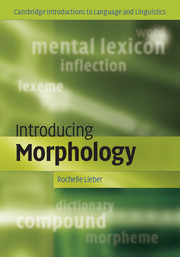Book contents
- Frontmatter
- Contents
- Preface
- The International Phonetic Alphabet
- Point and manner of articulation of English consonants and vowels
- 1 What is morphology?
- 2 Words, dictionaries, and the mental lexicon
- 3 Lexeme formation: the familiar
- 4 Productivity and creativity
- 5 Lexeme formation: further afield
- 6 Inflection
- 7 Typology
- 8 Words and sentences: the interface between morphology and syntax
- 9 Sounds and shapes: the interface between morphology and phonology
- 10 Theoretical challenges
- Glossary
- References
- Index
8 - Words and sentences: the interface between morphology and syntax
- Frontmatter
- Contents
- Preface
- The International Phonetic Alphabet
- Point and manner of articulation of English consonants and vowels
- 1 What is morphology?
- 2 Words, dictionaries, and the mental lexicon
- 3 Lexeme formation: the familiar
- 4 Productivity and creativity
- 5 Lexeme formation: further afield
- 6 Inflection
- 7 Typology
- 8 Words and sentences: the interface between morphology and syntax
- 9 Sounds and shapes: the interface between morphology and phonology
- 10 Theoretical challenges
- Glossary
- References
- Index
Summary
CHAPTER OUTLINE
In this chapter you will learn about the intersection between morphology and syntax, which is the study of sentence structure.
We will examine morphological processes like passivization and causativization that change the number of arguments of a verb.
We will look at phenomena that sit on the borderline between word formation and syntax: clitics, phrasal verbs like call up in which the two parts can sometimes be separated in sentences, and compounds that contain whole phrases or even whole sentences.
KEY TERMS
valency, argument, active, passive, anti-passive, causative, applicative, noun-incorporation, clitic, phrasal verb, phrasal compound
Introduction
As you've learned so far in this book, morphology is concerned with the ways in which words are formed in the languages of the world. Syntax, in contrast, is concerned with identifying the rules that allow us to combine words into phrases and phrases into sentences. Morphology and syntax, then, are generally concerned with different levels of linguistic organization. Morphologists look at processes of lexeme formation and inflection such as affixation, compounding, reduplication, and the like. Syntacticians are concerned, among other things, with phrase structure and movement rules, and rules concerning the interpretation of anaphors and pronouns. Nevertheless, there are many ways in which morphology and syntax interact.
We saw in chapter 6 that inflectional morphology is defined as morphology that carries grammatical meaning; as such it is relevant to syntactic processes. Case-marking, for example, serves to identify the syntactic function of an NP in a sentence.
- Type
- Chapter
- Information
- Introducing Morphology , pp. 143 - 156Publisher: Cambridge University PressPrint publication year: 2009



